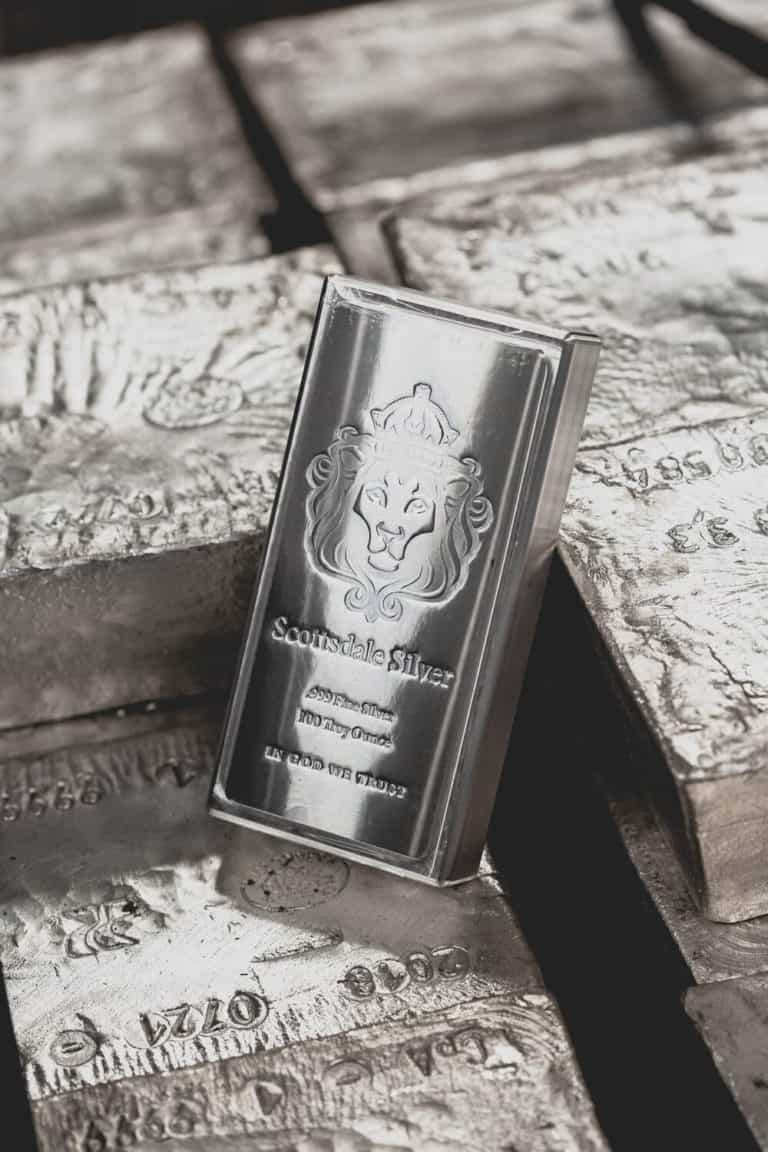- Our content is independently written and reviewed by trusted reviewers & fact-checkers.
- Your information is never sold. We can earn money by connecting you with top Gold IRA Companies. Learn how our reviews work.
- Want to learn more? Meet our authors and explore our editorial policy.

Understanding gold karats is important for a few key reasons. Primarily, it can help you determine the purity of the gold and, hence, its value. It can also help you determine the durability of gold items.
So, this know-how is really useful when you’re buying or selling gold.
Table of Contents
The Different Karats of Gold
When you buy gold, you’ll realize that it comes in different karats. The term karat refers to the purity of gold and the more pure it is, the higher its karat.
With that in mind, here are the different karats of gold.
10k Gold – The Economical Option
10 karat (10k) gold is made up of 41.7% gold and 58.3% other metals, like silver, copper, nickel, and zinc. This mix makes 10k gold less pure compared to other types of gold.
In numerous countries, including the United States, 10k gold is considered the minimum gold content required to classify a piece as genuine gold. Although it isn’t as valuable as gold with higher gold content, it remains a popular choice for jewelry among consumers.
Common Uses
Due to its strength and affordability, 10k gold is often used in bracelets, pendants, brooches, rings, and other pieces that require durability. It’s also used in dental applications, given its high resistance to corrosion.
Pros
- Affordability: 10k gold is more budget-friendly due to its lower gold content.
- Durability: The higher amount of alloy in 10k gold makes it more resistant to scratches and dents, which means it’s good for everyday wear.
- Less likely to tarnish: 10k gold holds its shine well over time due to its strong alloy mix.
Cons
- Color: 10k gold may not have the rich, vibrant color of higher carat gold and can look slightly duller.
- Potential for allergic reactions: Due to a higher percentage of alloy metals, those with sensitivities or allergies to certain metals may experience discomfort.
- Perceived value: 10k gold does not carry the prestige of higher karat golds, potentially impacting the perceived luxury value of the jewelry.
14k Gold – The Balanced Choice
14 karat (14k) gold is made up of 58.3% gold and 41.7% alloy. This karat provides a balance between gold content, durability, and affordability, making it one of the most popular choices for jewelry.
With over half of its composition being gold, 14k offers a purer product than 10k, yet remains more affordable than higher karats. Its color is also more vibrant than 10k gold, yet it retains significant strength due to its alloy content.
Common Uses
14k gold is commonly used in fine jewelry, such as engagement rings and wedding bands, earrings, necklaces, and bracelets. It’s popular in fine jewelry because of its unique combination of gold purity, beauty, strength, and affordability.
Pros
- Durability: 14k gold is notably durable and recommended for jewelry that is worn daily due to its good level of resistance to wear and tear.
- Affordability: It’s more affordable in contrast to higher karat alloys such as 18k or 24k, making it more accessible for a wider range of consumers.
- Color: It offers a pretty balance between gold content and alloy metals, resulting in a warmer, more subtle color.
Cons
- Price: Although it contains more gold than lower karat gold, 14k gold is less valuable than its higher karat counterparts.
- Prone to Damage: While it’s more durable than higher karat gold, it can still sustain scratches and dents.
- Maintenance: Because it contains mixed alloys, 14k gold may require more frequent cleaning and polishing to keep its distinct luster.
18k Gold – The Luxurious Middle Ground
18 karat gold consists of 75% gold and 25% alloy metals. Its high gold content gives it a bright, rich yellow color and makes it more valuable and luxurious than 14k and 10k gold.
Common Uses
Due to its deep color and high percentage of gold, 18k gold is often used for high-end jewelry like engagement rings, wedding bands, and other heirloom-quality pieces. Its luxurious quality also makes it popular for watches and other luxury items.
Pros
- Quality: 18k gold is considered high quality and is preferred by many individuals due to its suitable blend of gold and alloy.
- Balanced Durability and Purity: With 75% gold content, 18k gold strikes a balance between durability and purity, making it less likely to get damaged than higher karat gold.
- Color: Richer and warmer than 14k gold, offering a fairly classic gold appearance.
Cons
- Price: Since it has a higher percentage of pure gold compared to 14k gold, it is more expensive.
- Potential for Damage: Because of its higher gold content, it is more prone to scratches and dents than 14k gold.
- Potential Allergic Reactions: Although it possesses a higher percentage of gold, its 25% alloy composition might still cause allergic reactions for some people sensitive to the specific metals used in the mix.
24k Gold – The Pinnacle of Purity
24 karat gold is pure gold. It doesn’t contain any added alloys, which gives it its rich, bright yellow color.
Since it’s 100% gold, it’s not only the purest gold you’ll find on the market but also the most expensive.
Common Uses
Due to its softness, 24k gold is often found in gold bars and coins for investment purposes.
In some cultures, it’s used to create jewelry for special occasions like weddings, although this jewelry is typically handled with care to prevent scratches and damage.
It’s also extensively used in electronics and medical devices due to its high conductivity and resistance to corrosion.
Pros
- Purity: 24k gold is pure gold as it contains no alloy metal.
- Rich Color: The presence of more gold results in a richer yellow appearance, giving the gold a distinct and desirable hue.
- Value: Due to its purity, 24k gold often has a high value.
Cons
- Softness: 24k gold is incredibly soft and malleable, making it more prone to scratches and deformations. This quality makes it less suitable for items like jewelry that may endure regular wear and tear.
- Cost: The high purity of 24k gold also contributes to its high cost.
- Practicality: Since 24k gold is very soft, it’s often not practical for certain applications like jewelry.
How to Identify Different Gold Karats
One of the easiest ways to identify a piece of gold jewelry’s karat is to look for stamps or hallmarks.
Here’s what the different marks indicate:
- 10k, 10kt, or 417: These indicate 10 karat gold.
- 14k, 14kt, or 585: These mark 14 karat gold.
- 18k, 18kt, or 750: These refer to 18 karat gold.
- 24k, 24kt, or 999: These signify 24 karat gold.
Keep in mind that not all gold jewelry has these markings. So when markings are absent or unreliable, you can use a gold testing kit.
But be aware that these tests use various acids, which can discolor or scratch your gold piece, so you should proceed with caution. Or you can simply take your jewelry to a jeweler and ask them to test it for you.
Considerations for Choosing Gold Karats
When it comes to choosing gold karats, you might want to take the following factors into consideration to ensure that you’re getting the best quality for your money.
Purpose
The primary purpose or use of the gold item can significantly affect the karat you choose. For instance, if the gold is used for fine jewelry, like an engagement ring or a pendant, you might consider higher karat gold, like 18k or 24k, for its vibrant gold color and a higher gold percentage.
However, if your gold piece is expected to experience regular wear and tear, such as a wedding band, lower karat gold, like 10k or 14k, might be wiser due to its durability.
Purity and Color
The higher the karat, the purer the gold content and the richer the color. For instance, 24k gold is 100% pure and boasts a bright, rich yellow color.
However, the lower the karat, the more alloys it contains, affecting not only the color but the price and durability as well.
10k gold, while having a lighter color, is more resistant to scratches due to its significant alloy content.
Personal Preferences and Style
Each karat of gold offers a distinct color and style. Higher karat golds, like 24k and 18k, have a richer color, often preferred for luxury jewelry pieces.
Mid-karat golds, such as 14k, offer a balance between color and durability, while lower karat golds, like 10k, are notably more durable, though offering a less vibrant color.
Therefore, consider your personal style and preference for the color and look of your jewelry when choosing a gold karat.
Allergies to Specific Metals
Gold alloys contain metals like copper, zinc, nickel, or silver, and some people are allergic to these metals.
Remember, lower karat gold contains more of these base metals than higher karat gold. So if you are allergic to any of these metals, go with higher karat gold, as it contains fewer of these types of alloy metals.
Plus, you can always ask what kind of metals are contained in the gold alloy before you buy.
Durability and Maintenance
Gold’s durability directly relates to its karat. Lower karat golds, such as 10k and 14k, are mixed with harder alloy metals, making them more durable and scratch-resistant, ideal for everyday wear.
Higher karat golds (18k, 24k) are purer and softer; therefore, they require more care and are less suited to vigorous daily activities.
Budget
Your budget will determine what kind of gold you can afford. Pure gold (24k) is the most expensive due to its high gold content, followed by 18k, 14k, and 10k as the least expensive.
Therefore, you’ll need to consider the quality and longevity you desire versus what you’re willing to spend.
High karat gold presents a greater upfront cost but may offer more satisfaction due to its purity and color.
Lower karat gold, on the other hand, offers affordability and durability, which might be the better investment.
Aging and Maintenance of Different Karats of Gold
In the longevity of gold, karat plays a key role. Pure gold (24k) remains vibrant due to its resistance to tarnishing.
Over time, lower karat gold, such as 10k, 14k, or 18k, may subtly change in appearance, darkening or dulling due to the reaction of alloy metals with external agents.
Regular cleaning can mitigate this effect, maintaining the item’s original shine. Though this aging process typically adds unique character to the jewelry over time.
Therefore, understanding how different gold karats age is essential for the long-term maintenance and satisfaction of your gold items.
That said, the following are some helpful tips on how to clean and maintain different gold karats.
10K and 14K Gold Care
Prepare a solution of warm water and a few drops of dish soap. Allow the gold piece to soak in the solution for 15-20 minutes. Using a gentle brush, lightly scrub the jewelry. Rinse with warm water and dry with a soft cloth.
Bear in mind that these are low karat golds and are more prone to tarnishing than other types of gold. Therefore, it’s important to avoid exposing either type of gold to harsh chemicals or abrasive materials that can scratch or damage the surface
18K and 24k Gold Care
For 18k and 24k gold, it’s highly recommended to use a professional gold cleaner since these two types of gold are soft and, therefore, more susceptible to scratching.
Storage and Handling
- Always store gold jewelry separately, either in individual soft pouches, separate compartments within a jewelry box, or wrapped in a soft cloth, to avoid tangling and scratches due to friction with other pieces. The more delicate the gold, the more important it is to keep them apart.
- Be mindful when wearing your gold jewelry. Remove them before engaging in strenuous activities, swimming, or doing household chores that could involve contact with chemicals and abrasive materials that may damage or scratch the gold surface.
- Gold can be affected by chemicals present in cosmetics, perfumes, and lotions. So, it’s better to put on your gold jewelry after you’re done applying these products to minimize the chance of discoloration or damage.
- Regularly inspect your gold jewelry for signs of wear and tear. If you notice any damage, repairs should be done by a qualified jeweler who can assure that the piece retains its original value.
Conclusion
The selection between 10k, 14k, 18k, and 24k gold truly depends on your specific needs and preferences. If durability and affordability are your priorities, 10k gold may serve you best.
For a balance between gold purity and strength, 14k gold is a smart choice. However, if your taste leans more towards higher purity and luxury, then you might consider 18k or even the utmost purity of 24k gold.
All things considered, each gold karat has its own distinct advantages, catering to a wide range of tastes, requirements, and budget constraints.
Frequently Asked Questions
What Does “Karat” In Gold Mean?
A karat is a measure of the purity of gold, with 24 karats representing pure gold. For example, 14k gold is 14 parts gold and 10 parts other metals.
What Karat Gold Is Best?
The “best” karat gold often depends on the specific use and preference of an individual. If you’re looking for a balance between durability and cost, 10k and 14k gold tend to be the optimal choices.
If you’re looking for higher quality gold that retains its shine and color for a longer period of time, 18k and 24k gold are your best bets.
What Karat Gold Is Best for Everyday Use?
10k gold is best for everyday use. It contains 41.7% gold and is the most durable due to the higher percentage of other metals. It’s also more affordable.
What Karat Gold Is Worth the Most?
24k gold, being pure gold, is worth the most as it contains 100% gold. However, it’s softer and more prone to scratches.
Why Is Gold Mixed With Other Metals?
Gold is mixed with other metals to improve its durability and change its color. Pure gold is soft and can wear out easily, so it’s alloyed with other metals for strength.
What Metals Are Typically Alloyed With Gold?
Gold is typically alloyed with metals like copper, silver, nickel, platinum, and zinc to improve its strength and durability.
What Is the Color Difference Between the Different Karats of Gold?
As the karat number decreases, the color of gold becomes less yellow due to the increased percentage of other metals. This is why 24k gold has a rich yellow, while 10k gold has a lighter yellow.
Which Karat Gold Is the Most Durable?
10k gold is the most durable because it contains the least amount of gold (41.7%) and a higher amount of other metals.
Which Karat Gold Is Best for Wedding Rings?
14k gold is commonly used for wedding rings due to its durability and bright gold color. It’s less expensive than 18k gold but more durable and will last over time.
Can I Wear Different Karats of Gold Together?
Yes, it’s perfectly fine to wear different karats of gold together. However, it’s important to note that harder karats (like 10k) could potentially scratch softer karats (like 24k) if they rub together often.
Does the Karat of Gold Affect Its Resale Value?
Yes, the karat of gold significantly affects its resale value. Higher karat gold (like 24k) will generally have a higher resale value than lower karat gold (like 10k), primarily due to the fact that it contains more gold.
How Can You Tell the Difference Between Karats of Gold?
Apart from color differences, it can be challenging to tell the difference between karats of gold just by looking at them. The most reliable way is to check the hallmark, a tiny stamp on the gold item indicating its karat (abbreviated as “K” or “KT”).
Does the Karat of Gold Affect the Weight of a Gold Item?
No, the karat of gold does not directly affect its weight. However, since higher karat gold contains more gold and less of other metals, two items of the same size but different karats may have slightly different weights.
Article Sources
At Gold IRA Blueprint, we dive deep into the world of gold IRAs, using trusted sources to back up our insights. Our sources range from official documents to expert interviews, ensuring our content is both accurate and reliable. We also draw on research from reputable publishers to give you the most comprehensive understanding possible. Check out our editorial policy to see how we maintain our high standards for accuracy and fairness. Also make sure to check out our Financial Review Process to have a better understanding of our process.
Britannica, T. Editors of Encyclopaedia (2013, March 8). karat. Encyclopedia Britannica. https://www.britannica.com/technology/karat
The Diamond Pro. (n.d.). Full Comparison of 10K, 14K, 18K and 24K Gold. Retrieved from https://www.diamonds.pro/education/10k-14k-18k-24k-gold-compared/.














